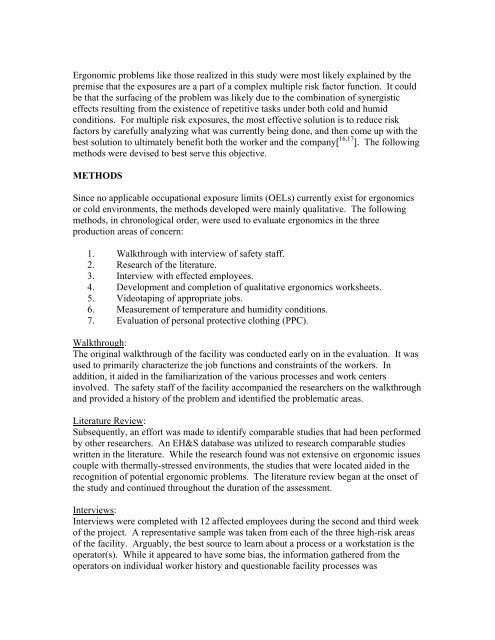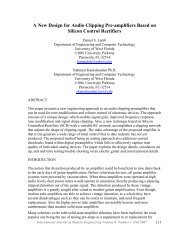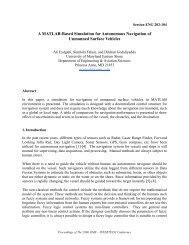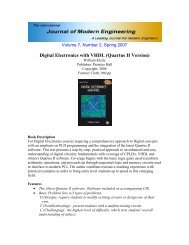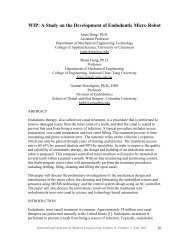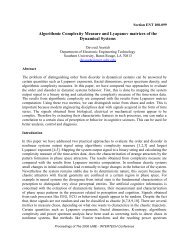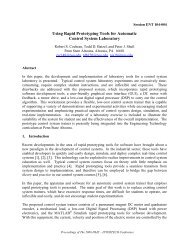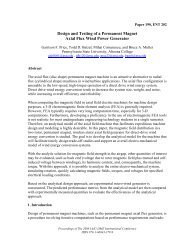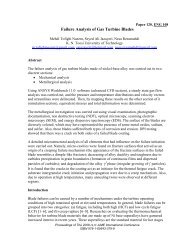The Effects of Coupling Repetitive Motion Tasks With a ... - IJME
The Effects of Coupling Repetitive Motion Tasks With a ... - IJME
The Effects of Coupling Repetitive Motion Tasks With a ... - IJME
You also want an ePaper? Increase the reach of your titles
YUMPU automatically turns print PDFs into web optimized ePapers that Google loves.
Ergonomic problems like those realized in this study were most likely explained by the<br />
premise that the exposures are a part <strong>of</strong> a complex multiple risk factor function. It could<br />
be that the surfacing <strong>of</strong> the problem was likely due to the combination <strong>of</strong> synergistic<br />
effects resulting from the existence <strong>of</strong> repetitive tasks under both cold and humid<br />
conditions. For multiple risk exposures, the most effective solution is to reduce risk<br />
factors by carefully analyzing what was currently being done, and then come up with the<br />
best solution to ultimately benefit both the worker and the company[ 16,17 ]. <strong>The</strong> following<br />
methods were devised to best serve this objective.<br />
METHODS<br />
Since no applicable occupational exposure limits (OELs) currently exist for ergonomics<br />
or cold environments, the methods developed were mainly qualitative. <strong>The</strong> following<br />
methods, in chronological order, were used to evaluate ergonomics in the three<br />
production areas <strong>of</strong> concern:<br />
1. Walkthrough with interview <strong>of</strong> safety staff.<br />
2. Research <strong>of</strong> the literature.<br />
3. Interview with effected employees.<br />
4. Development and completion <strong>of</strong> qualitative ergonomics worksheets.<br />
5. Videotaping <strong>of</strong> appropriate jobs.<br />
6. Measurement <strong>of</strong> temperature and humidity conditions.<br />
7. Evaluation <strong>of</strong> personal protective clothing (PPC).<br />
Walkthrough:<br />
<strong>The</strong> original walkthrough <strong>of</strong> the facility was conducted early on in the evaluation. It was<br />
used to primarily characterize the job functions and constraints <strong>of</strong> the workers. In<br />
addition, it aided in the familiarization <strong>of</strong> the various processes and work centers<br />
involved. <strong>The</strong> safety staff <strong>of</strong> the facility accompanied the researchers on the walkthrough<br />
and provided a history <strong>of</strong> the problem and identified the problematic areas.<br />
Literature Review:<br />
Subsequently, an effort was made to identify comparable studies that had been performed<br />
by other researchers. An EH&S database was utilized to research comparable studies<br />
written in the literature. While the research found was not extensive on ergonomic issues<br />
couple with thermally-stressed environments, the studies that were located aided in the<br />
recognition <strong>of</strong> potential ergonomic problems. <strong>The</strong> literature review began at the onset <strong>of</strong><br />
the study and continued throughout the duration <strong>of</strong> the assessment.<br />
Interviews:<br />
Interviews were completed with 12 affected employees during the second and third week<br />
<strong>of</strong> the project. A representative sample was taken from each <strong>of</strong> the three high-risk areas<br />
<strong>of</strong> the facility. Arguably, the best source to learn about a process or a workstation is the<br />
operator(s). While it appeared to have some bias, the information gathered from the<br />
operators on individual worker history and questionable facility processes was


